Sustainable Water Allocation in Umarkhed Taluka through Optimization of Reservoir Operation in the Wardha Sub-Basin, India
Abstract
:1. Introduction
1.1. Previous Studies of Umarkhed
1.2. Climate Change and Water Scarcity
1.3. Study Objective
2. Modeling Methodology
2.1. Model Data and Assumptions
2.2. Hydrologic Model Simulation
2.3. Calibration and Validation
2.4. GAMS Optimization Model
2.4.1. The Hydrologic Concept behind the Model
2.4.2. The Objective Function
2.4.3. The Parameters and the Decision Variables
2.4.4. The Constraints
2.5. Integration of the Model
3. Results
4. Discussion
4.1. Reservoir Storage Pattern
4.2. Downstream Water Allocation Analysis
5. Recommendations
6. Summary
Supplementary Materials
Author Contributions
Funding
Data Availability Statement
Acknowledgments
Conflicts of Interest
References
- Jain, S.K.; Kumar, V. Trend analysis of rainfall and temperature data for India. Curr. Sci. 2012, 102, 37–49. [Google Scholar]
- Bodh, P.C. Farmers’ Suicides in India: A Policy Malignancy; Taylor & Francis: Abingdon, UK, 2019. [Google Scholar]
- Gawande, S. GSG College Meeting with CU—Boulder MENV. January 2020. Available online: https://www.colorado.edu/menv/2020/02/04/menv-team-collaborates-gopikabai-sitaram-gawande-college-and-student-and-education (accessed on 5 June 2021).
- Naga, S.P.; Venkata, R.K.; Shashi, M. Intra- and interannual streamflow variations of Wardha watershed under changing climate. ISH J. Hydraul. Eng. 2020, 26, 197–208. [Google Scholar] [CrossRef]
- Gujja, B.; Dalai, S.; Shaik, H.; Goud, V. Adapting to climate change in the Godavari River basin of India by restoring traditional water storage systems. Clim. Dev. 2009, 1, 229–240. [Google Scholar] [CrossRef]
- Garg, V.; Dhumal, I.R.; Nikam, B.R.; Thakur, P.K.; Aggarwal, S.P.; Srivastav, S.K.; Kumar, S. Water resources assessment of Godavari river basin, India. In Proceedings of the ACRS Conference 2016, Colombo, Sri Lanka, 17–21 October 2016; Volume 17. [Google Scholar]
- Tupe, S.; Joshi, V. Trends in agriculture of Yavatmal Maharashtra (India): District Level Analysis. Agro Econ. 2019, 6, 87–92. [Google Scholar]
- Sandrp. Godavari Basin in Maharashtra: A Profile. 2017. Available online: https://sandrp.in/2017/03/08/godavari-basin-in-maharashtra-a-profile (accessed on 15 November 2021).
- Gosain, A.K.; Rao, S.; Basuray, D. Climate change impact assessment on hydrology of Indian river basins. Curr. Sci. 2006, 90, 346–353. [Google Scholar]
- Das, J.; Umamahesh, N.V. Downscaling Monsoon Rainfall over River Godavari Basin under Different Climate-Change Scenarios. Water Resour. Manag. 2016, 30, 5575–5587. [Google Scholar] [CrossRef]
- Feldman, A.D. Hydrologic Modeling System HEC-HMS Technical Reference Manual [Computer Software Technical Reference Manual]; U.S. Army Corps of Engineers: Washington, DC, USA, 2000. [Google Scholar]
- Fleming, M.J.; Doan, J.H. HEC-geoHMS Geospatial Hydrologic Modeling Extension [Computer Program Documentation]; U.S. Army Corps of Engineers: Washington, DC, USA, 2009. [Google Scholar]
- Roy, P.S.; Meiyappan, P.; Joshi, P.K.; Kale, M.P.; Srivastav, V.K.; Srivastava, S.K.; Krishnamurthy, Y.V.N. Decadal Land Use and Land Cover Classifications across India, 1985, 1995, 2005; ORNL DAAC: Oak Ridge, TN, USA, 2016. [Google Scholar]
- Brouwer, C.; Heibloem, M. Irrigation Water Management: Irrigation Water Needs (Training Manual No. 3); FAO: Rome, Italy, 1986. [Google Scholar]
- Worldometer. Water Use in India. 2017. Available online: https://www.worldometers.info/water/india-water (accessed on 15 November 2021).
- Roy, D.; Begam, S.; Ghosh, S.; Jana, S. Calibration and validation of HEC-HMS model for a river basin in eastern India. ARPN J. Eng. Appl. Sci. 2013, 8, 40–56. [Google Scholar]
- Loucks, D.P.; Beek, E.V. Water Resources Systems Planning and Management; Elsevier: Amsterdam, The Netherlands, 2017. [Google Scholar] [CrossRef]
- Kallrath, J. Modeling Languages in Mathematical Optimization; Springer: Berlin/Heidelberg, Germany, 2013; Available online: https://link.springer.com/book/10.1007/978-1-4613-0215-5 (accessed on 15 November 2021).
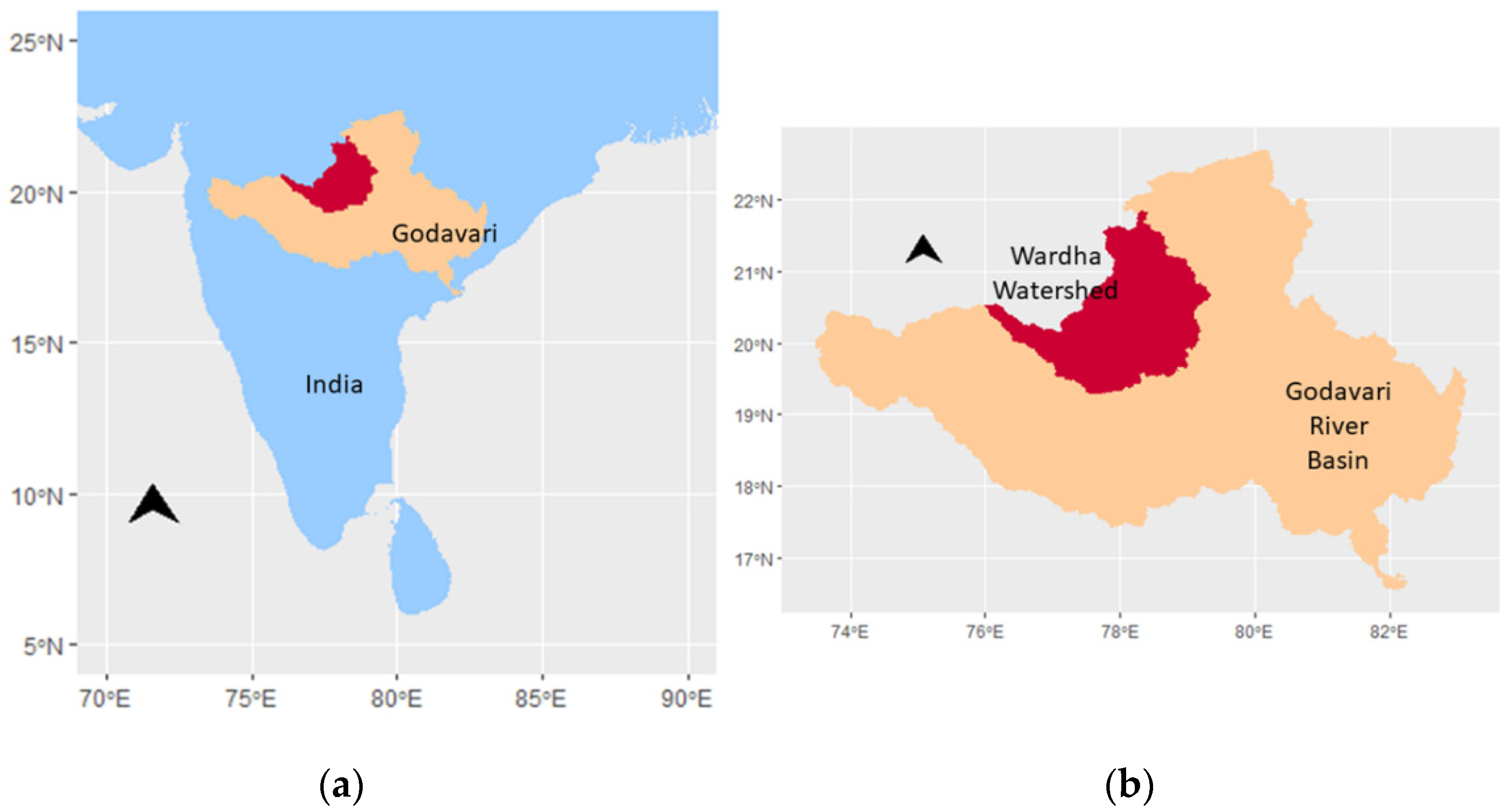
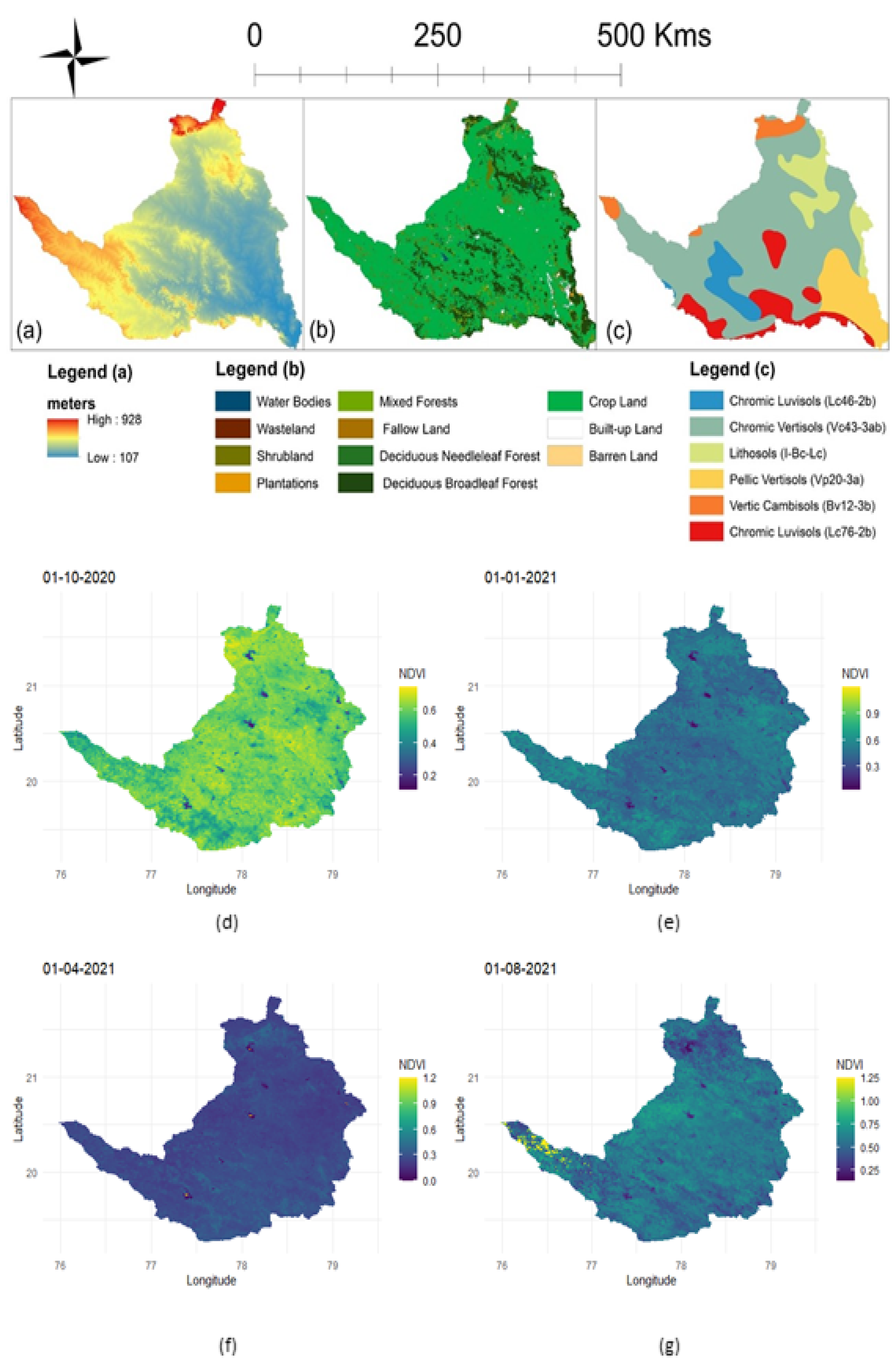

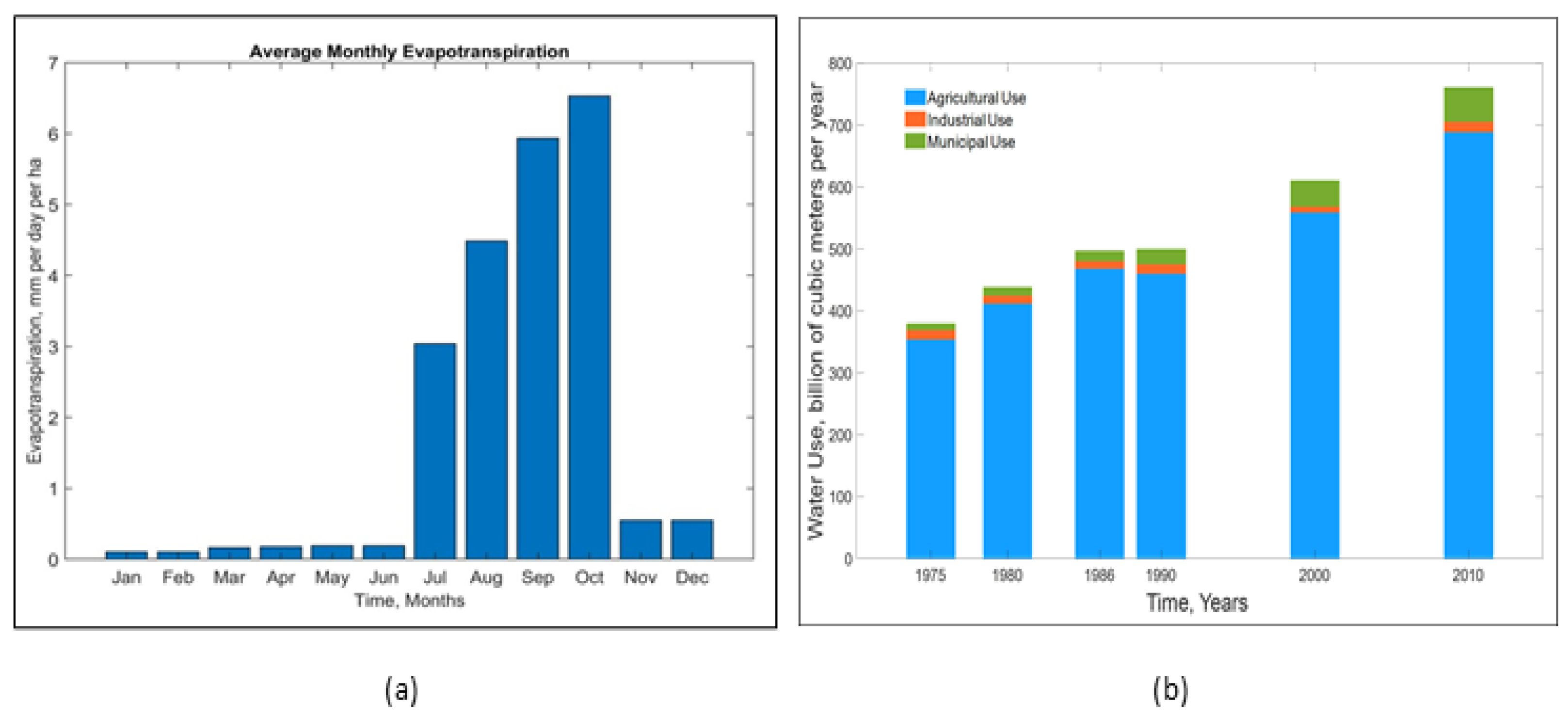
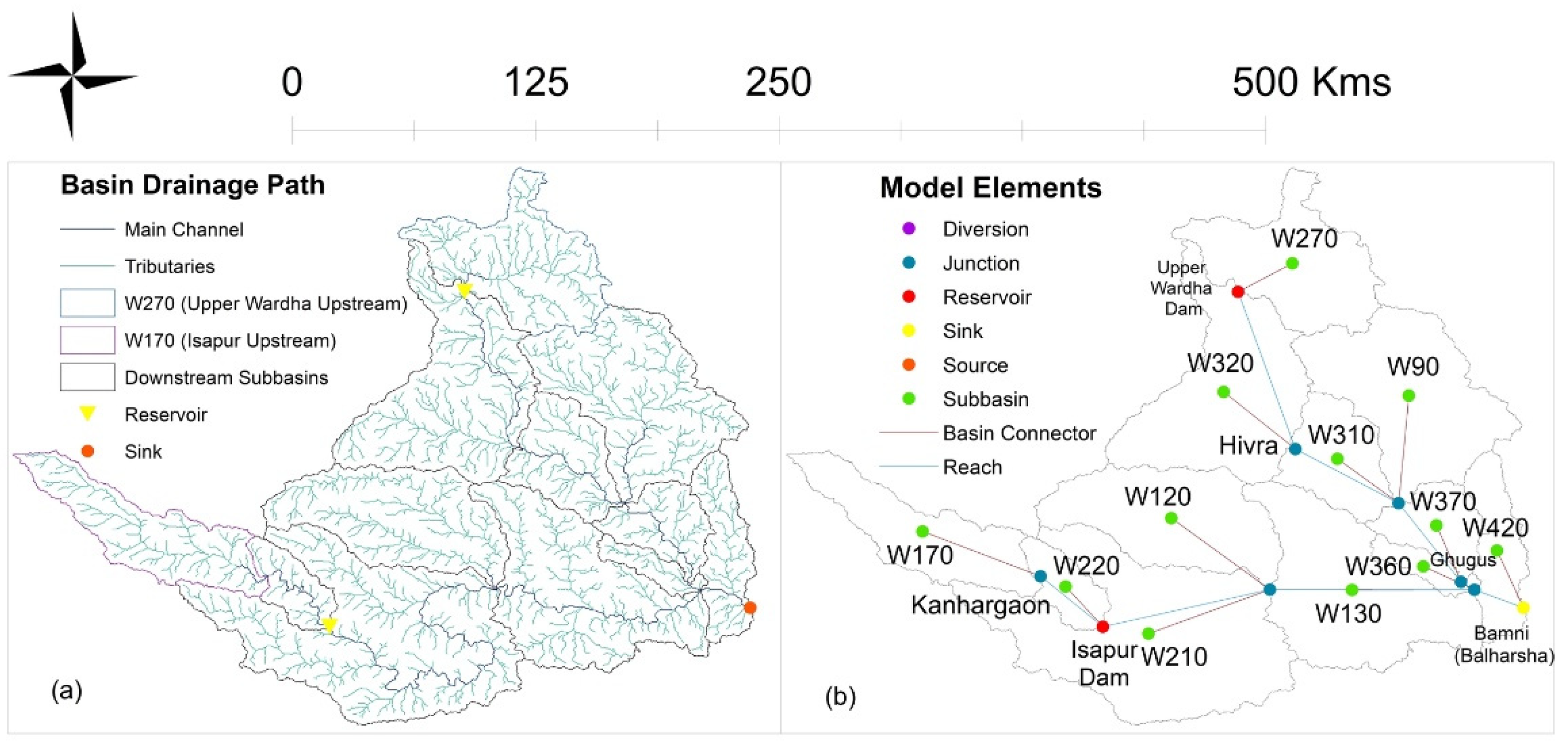

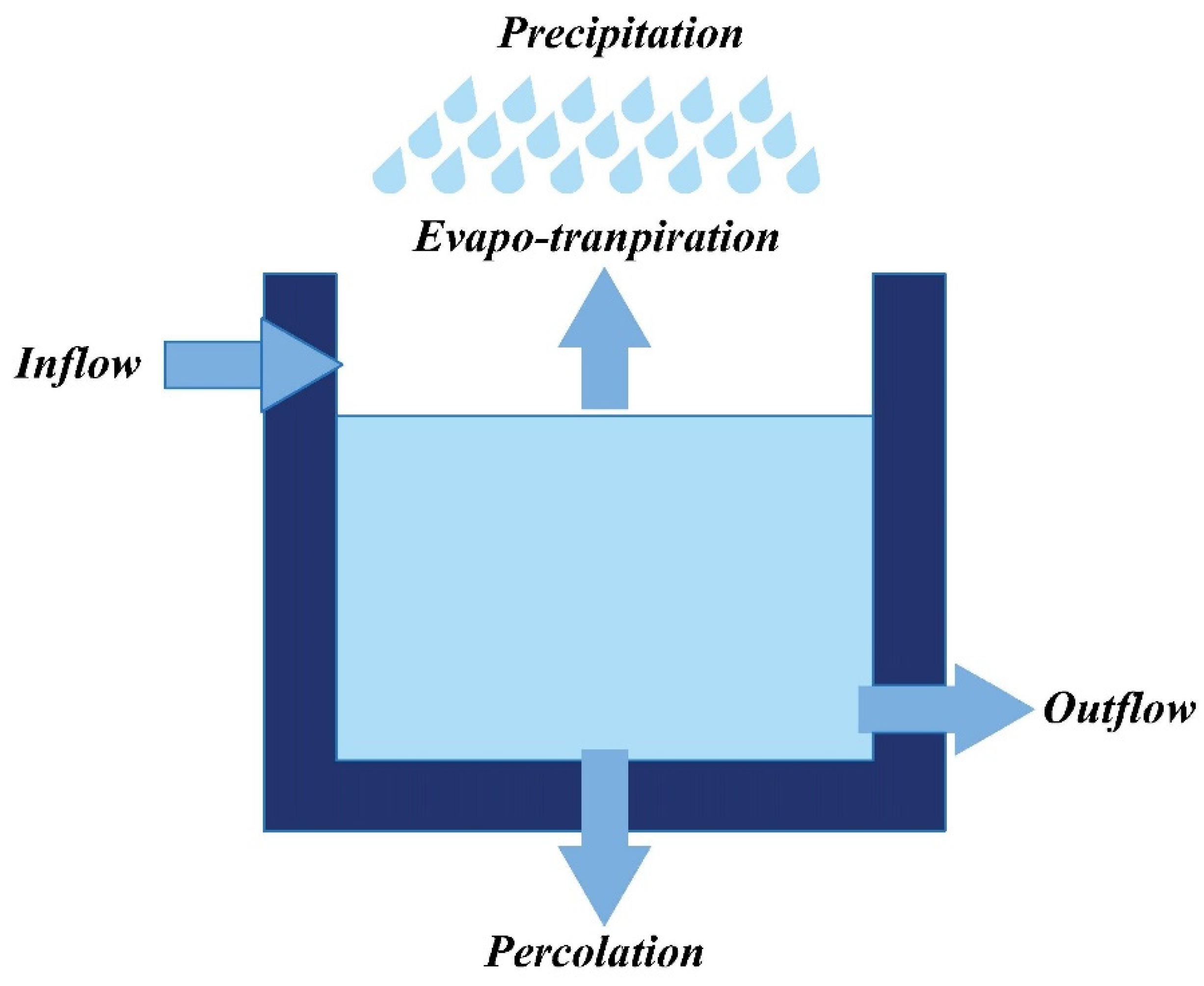
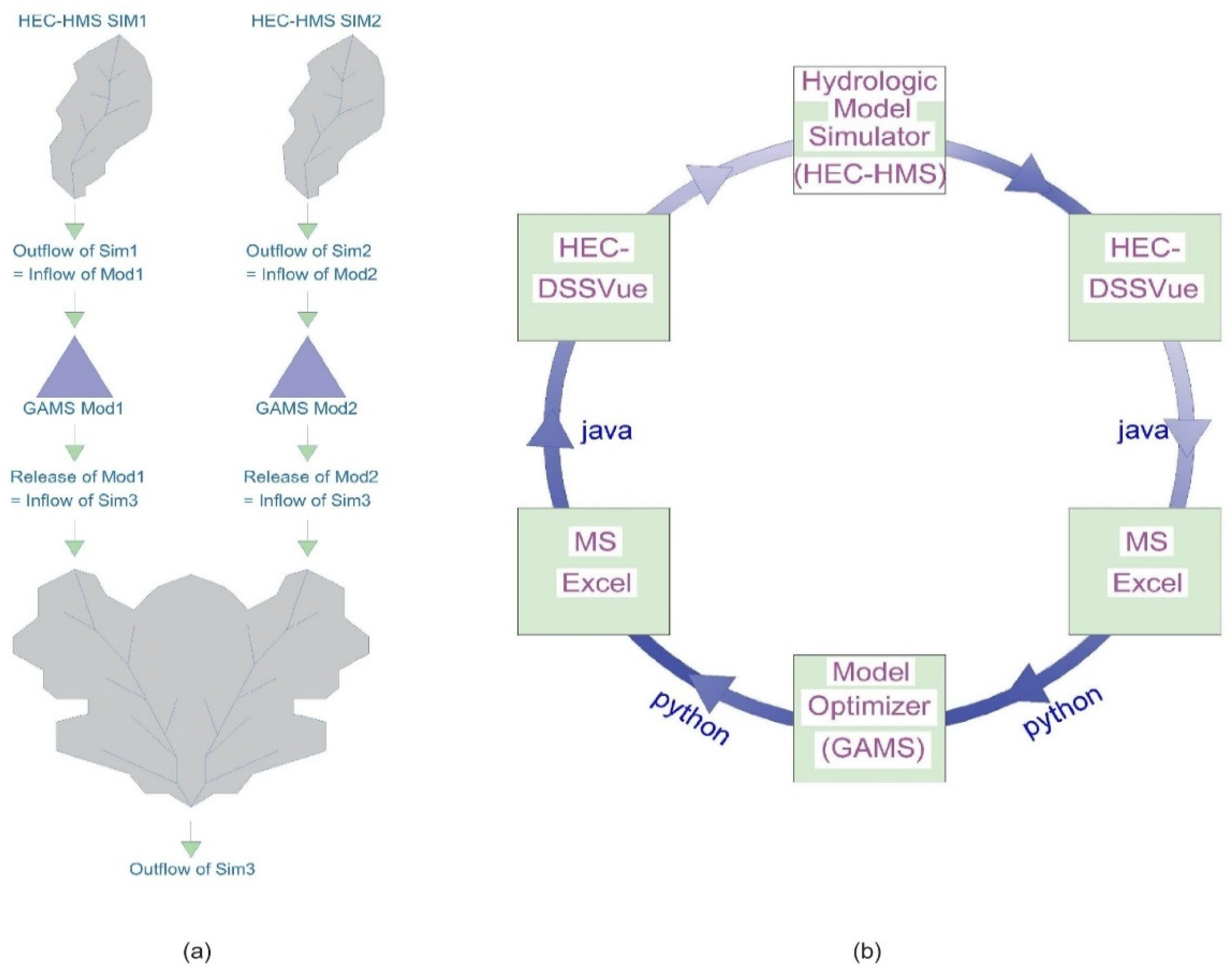
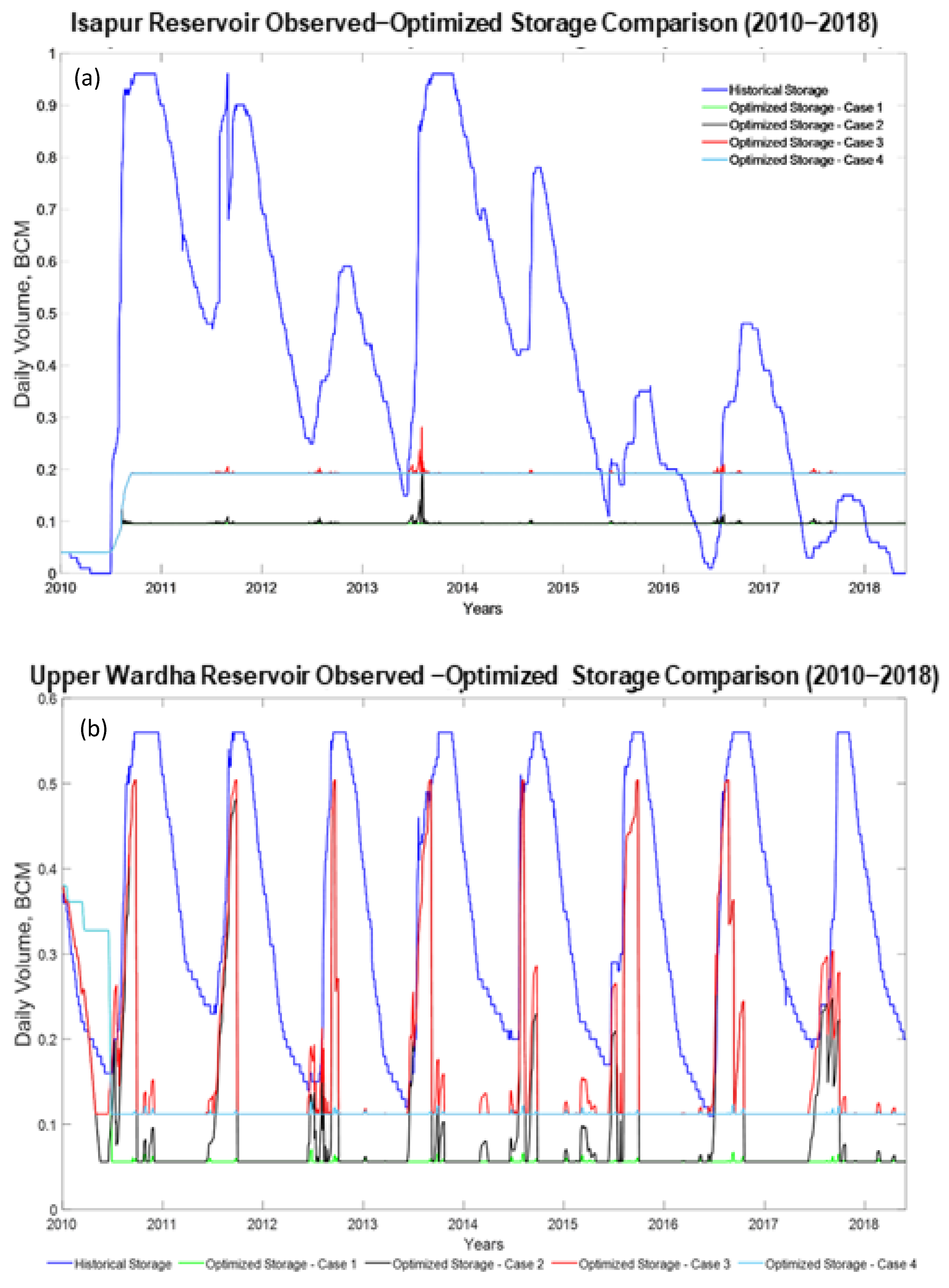
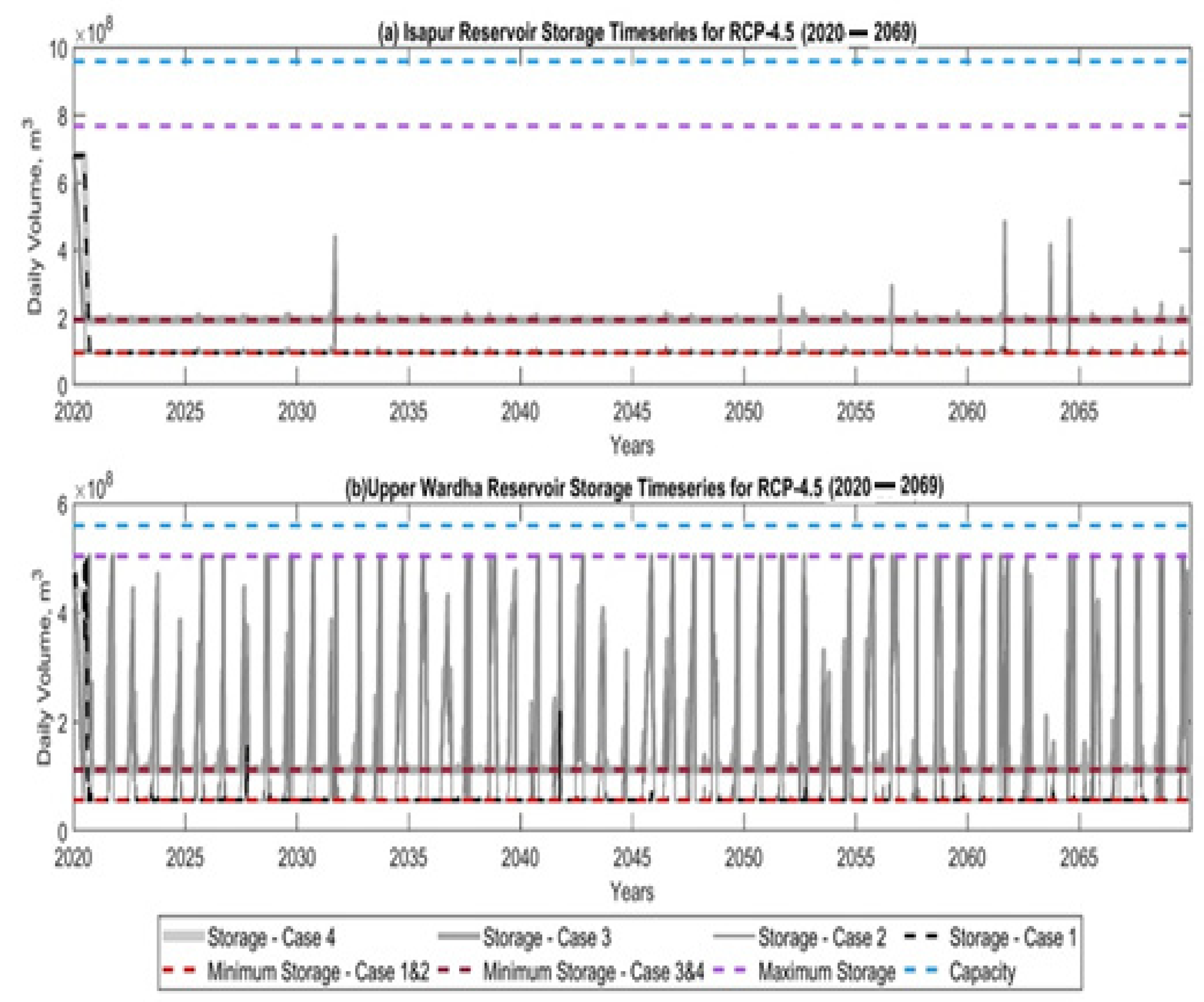
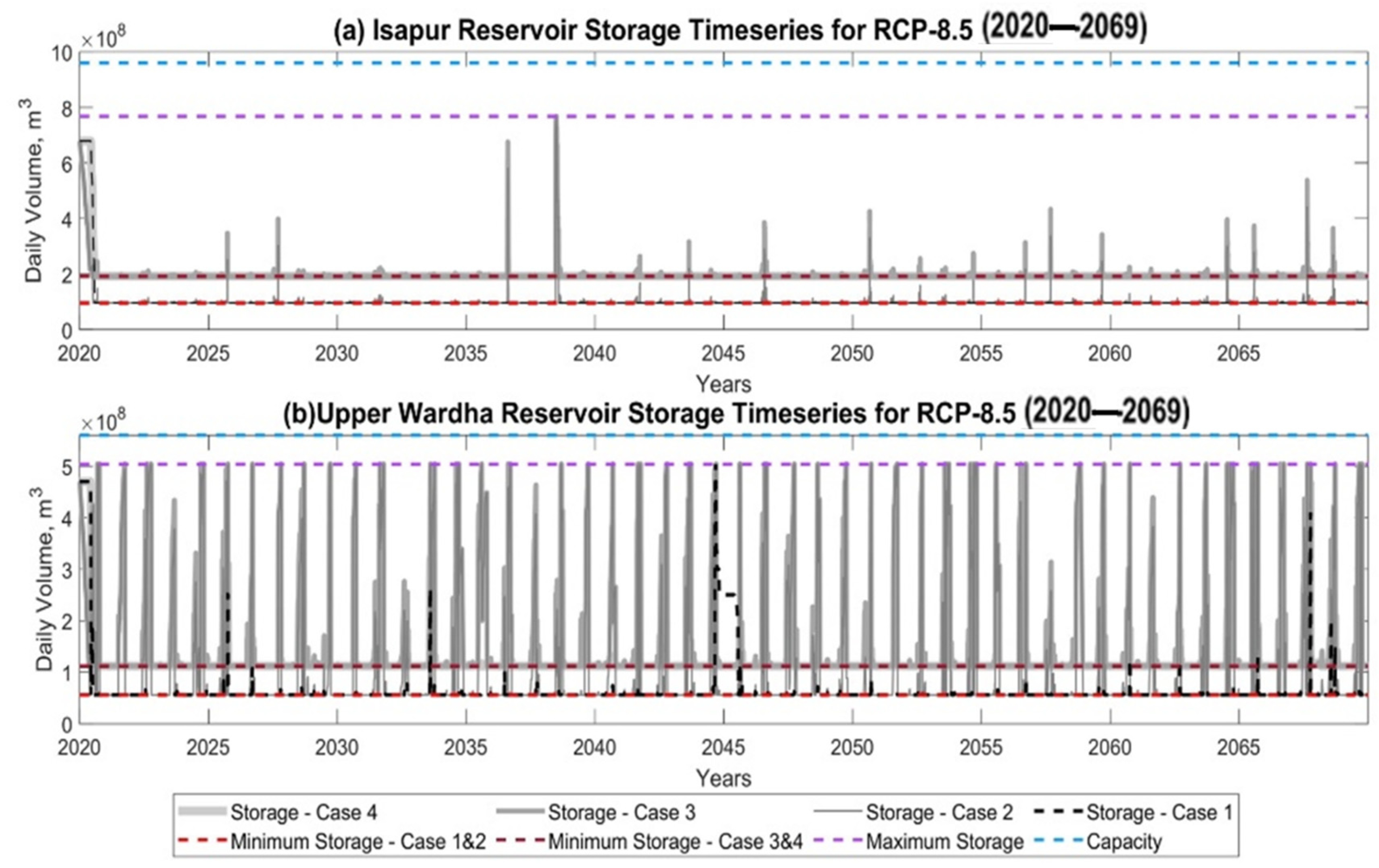

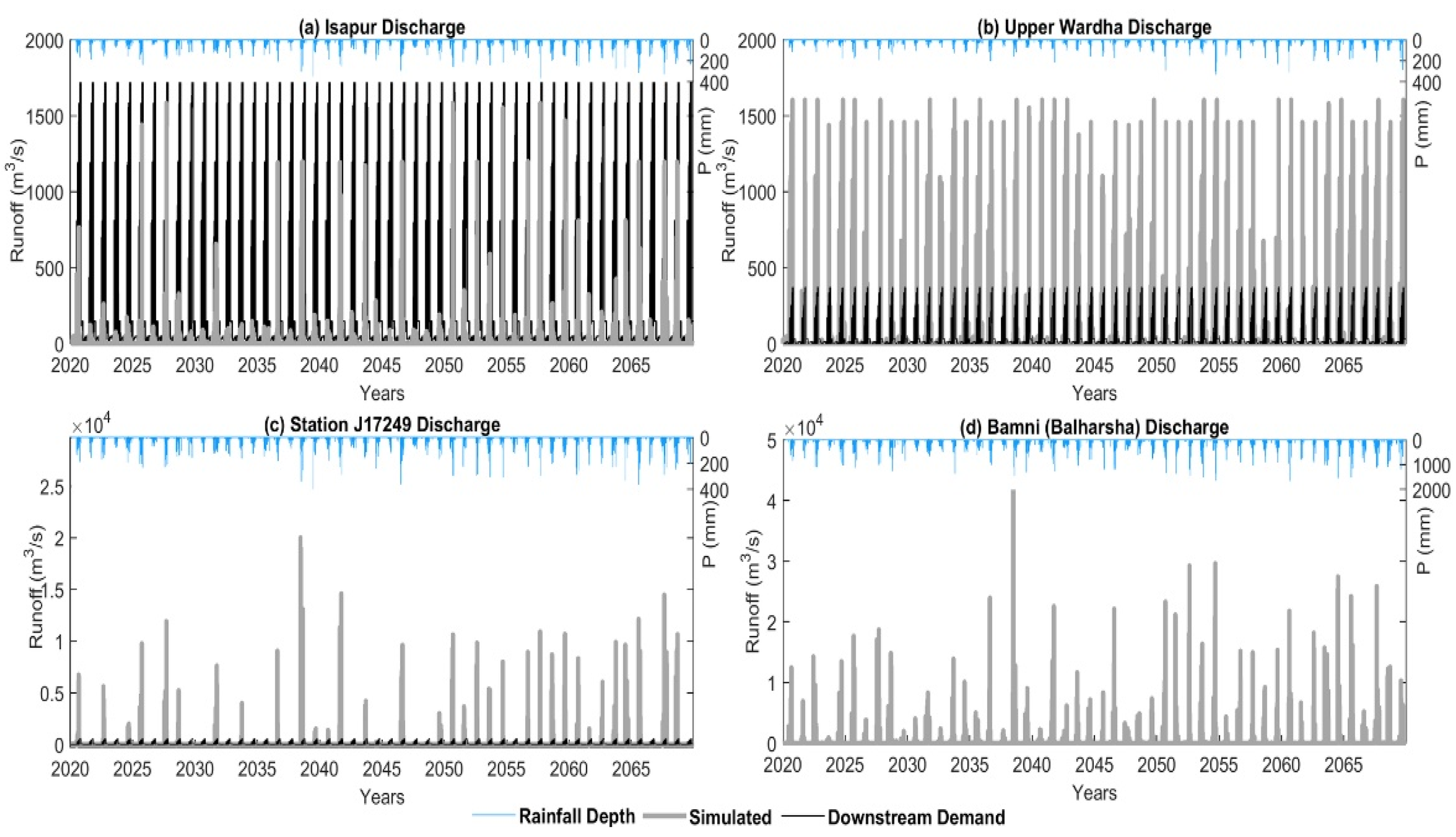
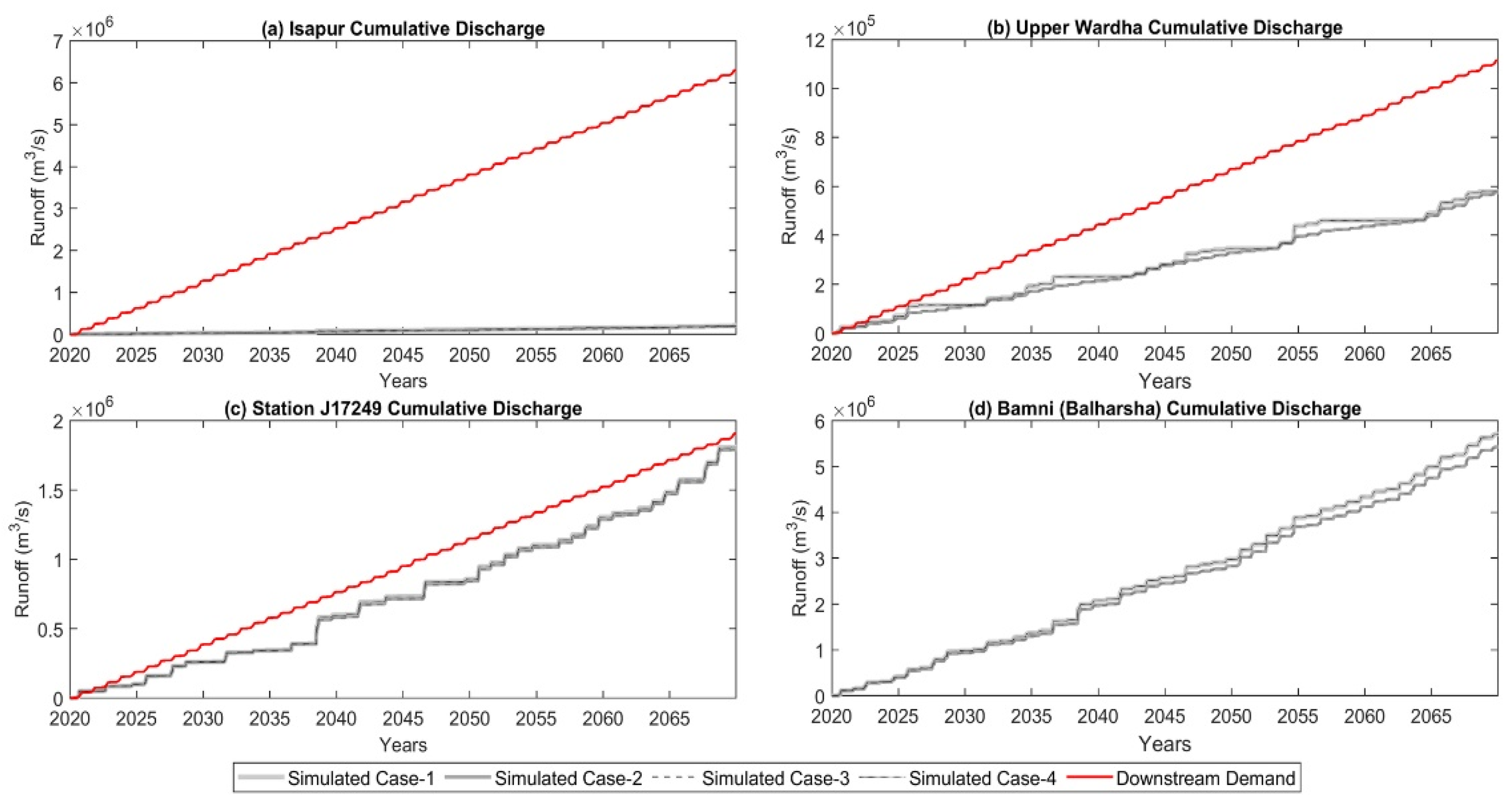
| SMA Parameters | Initial Values | Final Values |
|---|---|---|
| Sub-basin Area () | 10,061.2 | 10,061.2 |
| Canopy storage (mm) | 3 | 35.236 |
| Initial Canopy Storage (%) | 0 | 0 |
| Surface storage (mm) | 12.7 | 347.2 |
| Initial Surface Storage (%) | 0 | 9 |
| Soil (%) | 30 | 1 |
| Groundwater 1 (%) | 30 | 7 |
| Groundwater 2 (%) | 30 | 10 |
| Max rate of infiltration (mm/h) | 4 | 0.167 |
| Impervious (%) | 5 | 0.2196 |
| Soil storage (mm) | 400 | 450 |
| Tension storage (mm) | 130 | 130 |
| Soil percolation (mm/h) | 0.3 | 0.4 |
| Groundwater 1 storage (mm) | 60 | 130 |
| Groundwater 1 percolation (mm/h) | 0.3 | 0.4 |
| Groundwater 1 coefficient (h) | 90 | 70 |
| Groundwater 2 storage (mm) | 80 | 200 |
| Groundwater 2 percolation (mm/h) | 0.3 | 0.5 |
| Groundwater 2 coefficient (h) | 250 | 350 |
| Time of Concentration (h) | 24 | 26.925 |
| Storage Coefficient (h) | 24 | 15.778 |
| Case 1 | Case 2 | Case 3 | Case 4 | |
|---|---|---|---|---|
| Mass balance/continuity equation | Equation (2) | |||
| Initial reservoir storage | Equation (4) | |||
| Reservoir storage limit | = 10% of capacity) | = 10% of capacity) | = 20% of capacity) | = 20% of capacity) |
| Maximum release rate | Equation (6) | Equation (7) | Equation (7) | Equation (6) |
| Minimum release rate | ||||
Publisher’s Note: MDPI stays neutral with regard to jurisdictional claims in published maps and institutional affiliations. |
© 2022 by the authors. Licensee MDPI, Basel, Switzerland. This article is an open access article distributed under the terms and conditions of the Creative Commons Attribution (CC BY) license (https://creativecommons.org/licenses/by/4.0/).
Share and Cite
Haidar, M.A.I.; Che, D.; Mays, L.W. Sustainable Water Allocation in Umarkhed Taluka through Optimization of Reservoir Operation in the Wardha Sub-Basin, India. Water 2022, 14, 114. https://doi.org/10.3390/w14010114
Haidar MAI, Che D, Mays LW. Sustainable Water Allocation in Umarkhed Taluka through Optimization of Reservoir Operation in the Wardha Sub-Basin, India. Water. 2022; 14(1):114. https://doi.org/10.3390/w14010114
Chicago/Turabian StyleHaidar, Md Atif Ibne, Daniel Che, and Larry W. Mays. 2022. "Sustainable Water Allocation in Umarkhed Taluka through Optimization of Reservoir Operation in the Wardha Sub-Basin, India" Water 14, no. 1: 114. https://doi.org/10.3390/w14010114
APA StyleHaidar, M. A. I., Che, D., & Mays, L. W. (2022). Sustainable Water Allocation in Umarkhed Taluka through Optimization of Reservoir Operation in the Wardha Sub-Basin, India. Water, 14(1), 114. https://doi.org/10.3390/w14010114








